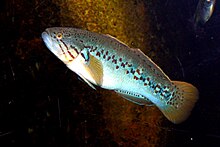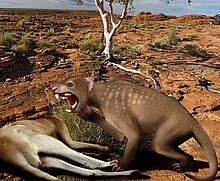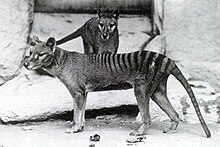Fauna of Australia
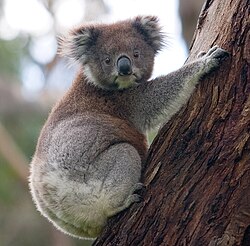
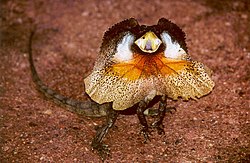
The fauna of Australia includes a large number of different animal species that are only found on this continent . 83% of mammals , 89% of reptiles , 90% of freshwater fish and insects, and 93% of amphibians are endemic species that only occur on the Australian continent . This high proportion is due to Australia's long geographical isolation and the geological stability of the continent. The consequences of climate changes, which are unusual in comparison to other continents, and their impact on the soil structure and the flora had a further influence .
The fauna of Australia is characterized by the relative rarity of native higher mammals . The ecological niche that these occupy on other continents is filled by the marsupial mammals , including the kangaroos , the climbing and predatory mammals . The Australian continent is also home to the five remaining species of egg-laying monastery . The high number of poisonous spiders , scorpions , octopuses , jellyfish , mussels and stingrays is also striking . It is also unusual that Australia is home to more venomous than non-venomous snakes .
Both the first human colonization of Australia around 50,000 years ago and the European colonization since 1788 have had a profound impact on the composition of the Australian fauna. The hunting , the introduction in Australia of non-native animal and plant species and land management has habitats so altered or even destroyed that many species have become extinct. The extinct animal species include, for example, the paradise parakeet , the pig's foot-nosed cone and a type of rat kangaroo . Many animal species are still endangered in their continued existence. Australia has therefore passed extensive legislation to protect native animal species and set up numerous nature reserves.
The evolution of the Australian fauna

Australia was once part of the southern supercontinent Gondwana , which also included South America , Africa , India and Antarctica . Gondwana began to break apart about 140 million years ago. Australia separated from the Antarctic continent during the Eocene 50 million years ago and was relatively isolated until the approach of the Indo-Australian plate with Asia during the Pliocene about 4.5 million years ago. After the Miocene , only a small part of the Asian fauna came to Australia. The Wallace Line , an imaginary boundary that separates the zoogeographical regions of Asia and Australasia, marks the plate-tectonic boundary between the Eurasian plate and the Indo-Australian plate. The lack of land bridges explains why only flying animals such as bats and birds were able to expand their range from Asia to Australia and develop their own species there.
The development of today's Australian fauna is significantly influenced by the climate and geology of the Australian continent. Australia apparently remained largely unaffected by the climatic changes typical of other continents. The unique fauna of Gondwana, which includes the marsupial, was able to develop in this niche.
15 million years ago, a desert climate developed on the Australian continent , which led to the evolution of numerous animal species adapted to very severe drought.
Characteristics of the Australian habitat
The Australian continent offers a number of very different habitats. Only a few animal species are therefore represented in the entire Australian continent.
A large part of Australia's continent consists of deserts , semi-deserts , steppes and savannas . Acacias and casuarines are typical plants in these habitats, although acacias only develop larger forests in the south. 20% of the Australian continent is covered with barbed grass. In the east, south-east and south-west of the continent there are also extensive evergreen eucalyptus forests , which often have a rich undergrowth due to the low shading of the trees. A number of the trees in Australia belong to the so-called pyrophytes , i.e. trees that are not only fire-resistant, but also need fire for the emergence of young seedlings.
Remains of large and very species-rich tropical rainforests can be found in the north of Queensland . Neither acacias nor eucalyptus trees can be found there. Instead, palm species , figs , screw trees , araucarias , tree ferns and bamboo dominate there . Large mangrove forests can also be found along the north and east coasts .
Many of the lakes shown on the maps of Australia only have water for certain periods of time. The Eyresee , which can have a water surface of up to 9,500 square kilometers, is only completely filled with water two to three times within a century.
Overall, Australia's climate is predominantly subtropical . The north, on the other hand, is tropical ; the Kimberley region is even considered to be the hottest area in the southern hemisphere. The southern outskirts of Australia, on the other hand, have a temperate climate . Tasmania , whose animal world is treated here due to its proximity to the Australian continent, has a relatively cool climate, which is characterized by large amounts of precipitation .
The specific range of an animal species within the Australian continent is only mentioned in this article as an exception. They can be read in more detail in the respective species article.
Mammals
From fossil finds, it is known that Australia has a long history of mammalian colonization .
Among the extinct species, the marsupial dominates here. For monotremes can be due to the fossil findings show that they in Australia since the early Cretaceous occur. Both marsupial mammals and higher mammals (placental animals) occurred on the Australian continent in the Eocene between 56 and 34 million years ago. The higher mammals became extinct, however, and did not reappear until the Pliocene , after Australia approached Indonesia . Since this period both bats and rodents have been found to be fossilized again as representatives of the higher mammals. In the course of evolutionary history, the marsupial developed species that not only developed similar ecological niches as the higher mammals in Eurasia and America. Many marsupials resemble species of higher mammals, which, like them, occupy the same ecological niche. This form of evolution is known as convergent evolution . The Tasmanian tiger resembles dogs such as the wolf in many ways . Glide pods and flying squirrels display similar adaptations to their habitat on trees, and the Australian anteater and South American anteater , which share similar body features, are burrowing insectivores .
Monotremes
Two of the five remaining monotons are found in Australia; the platypus (only in Australia) and the short-billed hedgehog (Australia and New Guinea) from the ant urchin family . The other three monotremes from the genus long-billed hedgehog are native to New Guinea only .
Monotremes differ from other mammals in their reproduction. They do not give birth to their young alive, but lay eggs instead. Platypuses also do not yet have mammary glands comparable to those of higher mammals. The platypus - a venomous, egg-laying, duck-billed, amphibious mammal - is often referred to as one of the strangest living things. When the British naturalist Joseph Banks bellows of this species was in the UK, many believed his colleagues at a cleverly-made fake. The English naturalist George Shaw (1751–1813) was the first to research the Australian fauna more intensively and to scientifically describe numerous species, including the platypus, for the first time. The short-billed hedgehog is endowed with similar peculiar characteristics as the platypus. It has hairy spines, a tubular snout, and a tongue that pops out of the snout up to 100 times a minute to catch termites .
Marsupials
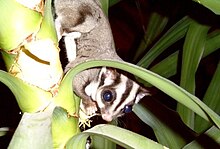
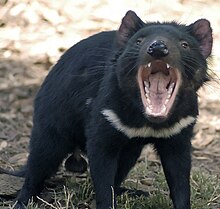

Australia is home to the world's largest marsupials. Marsupial mammals are characterized by the fact that they raise their young in a bag. Carnivorous marsupials, such as the predatory mammals, are still represented by two existing families, the predatory mammals and the Myrmecobiidae , of which only the ant colonist, also known as numbat, has survived to this day.
The thylacine (or 'Tasmanian Tiger') was the last surviving member of the family of Thylacinidae . The last individual of this species died in captivity in 1936. The Tasmanian devil , also known as the marsupial devil, died out on the Australian mainland around 600 years ago and now only lives in the wild in Tasmania . The four species of the bag marten are threatened with extinction just like this one. The remaining representatives of the predator mice are the pouch mice , most of which weigh less than 100 grams.
The Australian nasal cones , which include the long-nosed cones and the rabbit- nosed cones , are the omnivores among the marsupial. There are a total of seven species in Australia, most of which are considered threatened. The relatively small animals have a number of characteristic body features in common: a plump body with a curved back and a long, pointed and flexible snout. The ears are large and pointed and the animals have long, thin legs and a long, pointed tail.
Herbivorous marsupials are classified in the order of Diprotodontia and divided into ten recent families. These include the ground-dwelling wombats , which mainly live on grass and roots. Wombats use their front teeth and powerful claws to dig extensive tunnel systems. To protect their young, their pouches are open to the rear, unlike those of other marsupials. They are predominantly crepuscular and nocturnal. The koala , one of Australia's most famous marsupials, is a tree-dwelling species that lives exclusively on eucalyptus leaves .
Bilchbeutler , Gleitbeutler , Ringbeutler , Zwerggleitbeutler , Kletterbeutler and Rüsselbeutler are further families of the Diprotodontia. They are predominantly tree-dwelling bag mammals, some species such as the proboscis mostly live on nectar . Species in this family vary in size from roughly that of a golden hamster to that of domestic cats . The short-head glide pouch from the glide pouch family is one of the most common mammal species in many regions of Australia. However, due to its purely nocturnal way of life, it is rarely seen.
For many people, kangaroos and rat kangaroos , along with the koalas, are among the animal species that are most associated with the fauna of Australia; the kangaroo also appears in the coat of arms of Australia . Rat kangaroos are closely related to actual kangaroos and used to be considered a subfamily of this group. However, they differ significantly from these in some aspects (especially in nutrition). The family includes eleven species, two of which are already extinct. With the exception of the musk rat kangaroo , which is diurnal and lives in rainforests, rat kangaroos are nocturnal and inhabit open forests or at least tree-lined areas. They spend the rest phases in nests. They build these from grass and twigs in hollow tree trunks or under overhanging branches, transporting the building material with their curled up tail.
Not all types of kangaroos correspond to our common perception of these animals: the most striking characteristic of almost all species are the large rear limbs, which are significantly larger than the front ones. Only in the tree kangaroos , which have adapted to life in the trees and no longer hop around, have the limbs approximately the same length. The tail is long, muscular and mostly hairy, it is often used as a support or balance. The species are similar in physique, but differ considerably in size. The shaggy rabbit kangaroo often only reaches 1 to 2 kg body weight, while the red giant kangaroo can weigh 90 kg. Kangaroos are herbivores that feed on a wide variety of plants depending on their habitat. They often occupy the same biological niches as the ungulates on other continents , and their digestive system has also developed convergent to these.
Higher mammals
In Australia higher mammals from the orders of the bats and rodents are originally native. The bats occur with six families in Australia, the rodents only with the family of long-tailed mice .
Bats and rodents are relatively young animal species in Australia. Bats have only been found in fossils for 15 million years and have likely settled on the Australian continent from Asia. This is also supported by the fact that although seven percent of the world's bat species occur in Australia, only two genera are endemic in Australia .
Rodents colonized Australia in several immigration events five to 10 million years ago and evolved into a number of species known as "ancient endemic" rodents, now represented by fourteen genera. These include species such as the Australian rabbit and bunny rats , Australian tree rats and the Australian wide-toothed rat . They are counted among the long-tailed mice, as is the genus of real rats , the representatives of which reached Australia from New Guinea a million years ago and developed into seven species that are collectively referred to as "New Endemic" rodents. The endemic rodents make up around 25% of the continent's mammalian fauna.

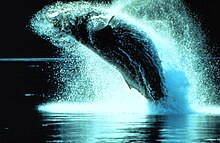
Since humans first colonized the Australian continent, they have introduced a number of higher mammals into Australia, which are found wild there today. The dingo is the first consciously introduced species. Fossil finds indicate that it was introduced by humans about 5,000 years ago. After the colonization by Europeans, the number of introduced species increased rapidly; Many species were introduced specifically in the 19th century by acclimatization societies in order to create an animal world that is reminiscent of Europe and to enrich Australia's fauna, which is perceived as being poor in species. These include the red fox introduced for hunting purposes , the brown hare , the red deer and the wild rabbit . Also fallow deer , sambar , chital , hog deer , Blackbuck and Javan Rusa owe their existence on the Australian continent that reason. Other domesticated species escaped as captive refugees - these include the domestic cat , domestic goat , domestic pig , water buffalo , domestic horse , domestic donkey, and dromedary . Only three species of the higher mammals were not intentionally introduced into Australia - namely the house mouse , the house rat and the brown rat .
Most of the introduced higher mammals have had serious effects on the native fauna and flora of Australia. The proliferation of wild rabbits and Australia's struggle against this perceived plague species are among the best-known examples of invasive neozoa . Feral domestic cats, as in other countries, have had a negative impact on native bird and rodent populations. Other examples show the consequences of the reckless settlement may have of animal species: Feral water buffalo presented for example in the march regions on Australia's north coast a serious ecological problem you reinforced by their footpaths and her. Wallowing the soil erosion , altered by their feeding behavior, the composition of the local Flora and their wallowing facilitated the penetration of salt water into freshwater habitats . They changed their habitat so permanently that the number of crocodiles living there, the Australian freshwater fish barramundi and similar native species decreased drastically. They also transmitted tuberculosis and bovine brucellosis to domestic cattle . The number of feral water buffalo, of which in 1985 more than half of the water buffalo worldwide not kept as pets lived in Australia with a population of 350,000 animals, is regulated today with extensive shooting programs. The dromedary population was estimated at 800,000 in 2007 and one million in 2009. No other country on earth has herds of this size, and the population is increasing by around 80,000 animals every year. The dromedaries also cause massive damage to the ecosystem and prevent efforts to re-green the desert-like landscapes in the outback.
46 marine mammals of the order Cetacea or whales can be observed in the coastal waters of Australia. Since the majority of the species have a worldwide distribution, a number of authors do not consider them to belong specifically to the fauna of Australia. Nine species of baleen whale , including the humpback whale , can be seen in the coastal waters of Australia. 37 species from all six genera of the toothed whale , including 21 species of dolphins , are also found in the coastal waters. The Australian snub fin dolphin was only described as a separate species in 2005. Some of the dolphins, such as the orca , are found in the coastal waters around Australia; others, such as the Irrawaddy Dolphin, are only found in the warmer, northern coastal waters.
The only herbivorous marine mammal in Australia, the dugong is found only on the northeast and northwest coasts and mostly inhabits the Torres Strait . This animal, up to 3 meters long and weighing 400 kilograms, is one of the endangered species, as the seagrass meadows on which it lives are increasingly endangered. In addition, eleven species of seals can be found in Australian coastal waters.
Birds


Australia is home to 800 species of birds . 350 of them are considered endemic to the zoogeographic region of Australia, New Guinea, and New Zealand . Even without naturalized species and wintering summer visitors, around two dozen species that are also native to Europe are represented in Australia. These include cormorants , silver egrets , silky egrets and cattle egrets , bitterns , brown ibis , birds of prey such as the black kite , osprey and peregrine falcon, as well as the barn owl , some types of claws such as the purple grouse , coot and mock grouse , terns such as the laughing , predatory , rose and sooty tern as well as the Cistensänger .
The fossil record for birds in Australia is only fragmentary, but some fossils from ancestors of today's species can already be proven for the late Oligocene . Some birds are part of Gondwana fauna , including the flightless ratites such as the emu and cassowary, and a large group of endemic parrots . The Australian parrots make up one sixth of the world's number in this family. The best known of its representatives is the budgie , which soon after its discovery became a popular housebird all over the world and is now bred in many different colors. The wild form is strictly protected and may not be exported. Among the most famous and typical of Australia representatives of birds include the cockatoos , including widespread in Australia cockatiel counts. The largest cockatoo species is the Palm Cockatoo , which in Australia only occurs on the Cape York Peninsula. The smallest parrot species in Australia is the masked dwarf parrot , which is distributed in three subspecies in tropical and subtropical rainforests of northeast Australia. Australia is also home to some species of lory . With all-color , musk , scale , blue-parted , dwarf musk and colored lory , this subfamily of parrots is only represented by a few species. Numerous representatives of the parakeets are also native to Australia. An unusual habitat for parrots is used by the cliff parakeet , which occurs only on the coastline of Australia and is only a few hundred meters from the sea. The golden-bellied parakeet, which is closely related to it, is one of the rarest bird species in Australia with a population of only around 200 individuals. Australia is also home to a number of endemic species of pigeon . These include the red -mirrored pigeon and the white-winged stone pigeon, two habitat specialists that occur in the far north of Australia. They only populate stony and rocky, strongly rugged terrain, as is characteristic of the Katherine Gorge , for example . The crested pigeon and the spinifex pigeon , which colonize almost all of Australia, have a very large distribution area.
There are ten species of the kingfishers family in Australia. The best known is certainly the Jägerliest (or Lachender Hans or Kookaburra ), the world's largest representative of the kingfishers. Its occurrence extends over all of eastern Australia and the southernmost foothills of western Australia. Its closest relative, the Haubenliest, is only slightly smaller and differs from its larger cousin mainly by the blue-colored wings. The Rotbürzelliest is the kingfisher with the largest range in Australia. Except for Tasmania , it can be found almost anywhere on the Australian continent. Its relatives Spiegelliest , Götzenliest and Halsbandliest also occur in Australia. The smallest member of this family of birds, azure kingfisher and Papua Fischer , close relatives of the domestic also in Central Europe Kingfisher are to be found both in northern Australia, but the distribution area of Azur Fischer also extends beyond a thin coastal strip south to Tasmania. The two rarest kingfishers in Australia are certainly the paradise reads , which can only be found from November to April on the Cape York Peninsula in northern Queensland and the yellow-billed birds , which only live in the almost inaccessible, northernmost tip of the Cape York Peninsula.
The green-blue rainbow spint is the only bee-eater representative in Australia. In Northern Australia these can be found all year round. Birds living further south are migratory birds which breed there in the summer months from October to March.
The number of passerine birds that can be found in Australia is also great . The evolutionary history of this family can also be traced back to the family of the fine finches , which is distributed from Africa to Eurasia to Australia. Basically the younger species of this family can be found in Australia and the older ones in Africa. For Australia typical representatives of the finches as an ornamental bird in Europe are very popular zebra finch and the now rare in their homeland become Gouldian Finch .
From Eurasia, swallows , larks , thrushes and nectar birds have populated the Australian continent in recent geological times. Similar to the higher mammals, acclimatization societies introduced a number of birds mainly in the 19th century, most of which came from Europe. Here, too, the motivation was to enrich the fauna of Australia, which was perceived as poor in species, and to create an animal world that was reminiscent of Europe. Some of the European species like the golden hammer and the greenfinch live in Australia without any negative impact on the bird population there. Other species such as the house sparrow , the blackbird and the European starling , however, have a negative impact on the Australian bird world; they displace less competitive species and destabilize Australia's ecosystem.
Over 200 species of seabirds live on Australia's coast, including a large number of migratory birds. Australia is at the southern end of a train route that stretches from Eastern Russia , Siberia and Alaska through Southeast Asia to Australia and New Zealand. Approximately two million birds follow this route to and from Australia each year.
The African pelican is one of the typical seabirds in Australia and can be found on almost all coasts. The most common species of gull is the herring head gull , which is only found in Australia and a few neighboring islands. The little penguin is the only representative of the penguins that breed on mainland Australia.
Reptiles


In Australia, crocodiles are native to both saltwater and freshwater . The saltwater crocodile , colloquially called Salty by the Australians , is the largest existing species of crocodile. It reaches a body length of up to seven meters and weighs more than 1000 kilograms. Contrary to its name, it can also be found in fresh water. It is feared because it attacks and kills people again and again. The saltwater crocodile is also bred on crocodile farms in Australia for its meat and leather . The second species of crocodile native to Australia is the Johnson crocodile , which lives exclusively in freshwater and is generally not dangerous to humans. Occasionally both species appear in the same river; this is possible by occupying various ecological niches . While the Johnson crocodile specializes in fish, the saltwater crocodile feeds more on birds and mammals.
The Australian coast is visited by six species of sea turtles , including the green turtle . 29 species of freshwater turtles are also native to Australia, which are assigned to eight genera of the Chelidae or snake-necked turtle family . Only one of them is restricted to Australia in its range. Land turtles, on the other hand, are absent in Australia.
Australia has more venomous snakes than non-venomous. They represent a total of seven families. The most poisonous, including the taipan and the tiger otter , belong to the family of poisonous snakes (Elapidae), of which 86 of the 200 species occur in Australia. Most people who die from snake bites in Australia die from the bite of brown snakes , which are also poisonous snakes . Many of the sea snakes found in the coastal waters of Australia are also extremely poisonous. Two species of warthog are also found on Australia's coast. Of the snakes , which are the most species-rich family of snakes , only eleven species can be found in Australia. None of these species are endemic to Australia ; they are considered to be relatively young immigrants from Asia. 15 species of giant snakes and 31 species of insectivorous blind snakes are also represented in Australia. The Australian amethyst python is the largest snake species on the continent. The less common green tree python has also found its habitat here. This extends over the northern rainforests of Cape-York.
More lizards live in Australia than anywhere else in the world. They represent five families. 115 species belong to 18 genera of geckos that can be found on the entire Australian continent except for Tasmania . The pinnipeds form a family of lizards that is predominantly endemic to Australia. The 34 species are very similar to snakes due to their elongated bodies, their back legs that have receded into scaly processes and the lack of front legs. These animals are able to make sounds. Due to common characteristics, they are considered to be related to the geckos. Only one of these species is not native to Australia.

The agamas are represented by 66 species from 13 genera. One of them is the frilled lizard , which opens its mouth in danger and thereby raises its brightly colored collar. The erect collar is additionally supported by elongated jawbones. In addition, it stands on its back legs and makes hissing noises and hits the ground with its tail. This makes it appear more threatening and larger than it is. To reinforce the impression, she often stands on a raised place. The collar of larger animals can protrude up to 30 centimeters from the body. With the collar turned up, she also regulates her body temperature. The thorn devil , which is particularly adapted to life in the Australian deserts, is also one of the agamas . The skin of the thorn devil is criss-crossed with tiny furrows. The capillary forces of the furrows direct all moisture towards the corners of the mouth, where the animal can absorb it. In this way, the lizard can take advantage of the morning dew of the cold desert nights or it can drink, for example by dipping a leg in the water.
26 species of monitor lizards , such as the Goulds monitor lizard , live in Australia, where they are known as goannas . The largest of these is the giant monitor , which can reach a body length of two meters, the smallest representative is the 38 centimeter long Gillens monitor . However, 50% of the lizards living in Australia, around 389 species, belong to the skinks . One of them is the blue-tongue skink , which has a very large and flexible, often bright blue tongue.
Amphibians
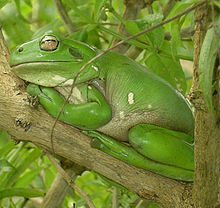
About five families of frogs with 227 species are native to Australia . The tail amphibians , however, are absent on this continent. The best-known representative of the amphibians, however, is an introduced species, the aga toad ( Bufo marinus ). It was naturalized from 1935 to control pests in sugar cane plantations . The attempt failed - the toads, however, spread rapidly in Australia and are now among the most hated neozoa . The cane toad defends itself against enemies with poisonous substances, which it secretes in particular from the two large posterior ear glands. The skin is covered with this secretion ; however, it can also be actively sprayed up to a distance of 30 centimeters. The eyes and oral mucous membranes of attackers are severely irritated by the poisons. For example, they can be deadly for mammals or larger reptiles if the toads eat them. In humans, mucous membrane and skin irritation occurs through mere contact. The introduction of the cane toad by humans has contributed to the destabilization of Australia's ecosystem. The sharp decline in the population of native reptiles is attributed, among other things, to their spread. Even crocodiles can perish after eating several toads.
The Australian southern frogs (Myobatrachidae i. W. S.) are among the diverse groups of native frogs, 122 of which are found here in 21 genera of 128 species. The two types of gastric breeder frogs ( Rheobatrachus ) represent a zoological curiosity, although they are now considered to be extinct or lost. There is also a large number of tree frogs from the family Hylidae ; these are mainly found in the rainforests of the north and east coast. About 68 species of the genus Litoria ( Australian tree frogs ) are represented on the continent. The best known is probably the large coral finger ( Litoria caerulea ). The water reservoir frog ( Cyclorana platycephala ), which occurs in arid regions, can absorb and store so much water through the skin as an adaptation to the dryness in its bladder and subcutaneous spaces that it appears completely puffy. Aborigines take advantage of this by looking for the frogs and using the water to drink.
The 19 Australian species of narrow-mouthed frogs (Microhylidae) are restricted in their range to the rainforests in the northeast. The family of real frogs, which is otherwise widespread worldwide, is represented by only one species, the Australian forest frog ( Rana daemeli ). It is also predominantly found in the Queensland rainforests .
The globally observable trend of a sharp decline in frogs, which has found its way into the specialist literature as the “ Amphibian Decline ”, can also be determined here. The exact causes have not yet been finally clarified. Among other things, the increased ultraviolet radiation - especially in Australia and the southern hemisphere - due to the falling ozone layer , a fungal disease and pesticides are seen as influencing factors (compare: amphibians ).
fishes
More than 4,400 species of fish inhabit Australia's waters, most of which live in the coastal seas. There are only 170 species of freshwater fish in Australia, 90% of which are found only here. This is due to Australia's long geographical isolation and the relative rarity of freshwater on this continent . One of the best-known freshwater fish is the barramundi , which is often fished.
Freshwater fish

Primary freshwater fish are the Australian lungfish , the salamander fish ( Lepidogalaxis salamandroides ), the bone- winged Scleropages jardinii and Scleropages leichardti , as well as the codfish . These only belong to five families. Some of the families can be traced back to Gondwana fauna , including the bonefish and the Australian lungfish, which is the most pristine of the lungfish still alive today. One of the most unusual fish is the salamander fish, which is found in the southwest of Western Australia. It is one of the smallest freshwater fish and survives dry periods by digging into the mud.
The secondary freshwater fish are more species-rich and descend from marine ancestors who migrated into freshwater. They can be divided into two groups. 70% of the freshwater species in the Australian fish world show a relationship with the tropical fish of the Indo-Pacific region. This group includes four types of eels ( Anguilla ), the Australian fresh herring ( Nematalosa erebi ) and the herring family Potamalosa richmondia , more kinds of the cross and coral catfish , the Hornhecht Strongylura krefftii , the wrestling halfbeak Arrhamphus sclerolepis , the rainbow fishes (Melanotaeniidae) and the Blue eyes (Pseudomugilidae). The cave-gill-slit eel ( Ophisternon candidum ), as well as another closely related species, live in the subterranean watercourses of northwest Australia. The family of the glass perch , which is represented by several species of the genera Ambassis and Denariusa , also belongs to this group.
The southern group mainly includes species that have their origin in temperate and cold waters and whose relatives also occur in New Zealand. There are three species of lampreys ( Geotria australis , Mordacia mordax , M. praecox ), of the New Zealand salmon the Australian smelt ( Retropinna semoni ), the Tasmanian smelt ( R. tasmanica ) and the Australian trout pike ( Prototroctes maraena ). This also includes the galaxies Aplochiton and Lovettia sealii as well as Pseudaphritis urvilli from the suborder of the Antarctic fish .
A number of freshwater fish have been released by humans in the waters of Australia. These include brown trout and rainbow trout , Atlantic salmon and king salmon , perch , carp and mosquito fish from the Gambus genus . Most of the species released have a negative effect on the native fish world of Australia. Mosquito fish are particularly aggressive animals that drive away other fish and eat their fins. In the waters in which they were released, there is a clear population decrease and in some cases also a regional extinction of small, native fish species. Scaturiginichthys vermeilipinnis is particularly threatened . The released trout species , which are also involved in the decline in Australian frog species, have a similar impact . Carp are a major contributor to the decline of underwater plants in Australian rivers.
Marine fish
Marine fish that occasionally visit the fresh water coming from the families of the tiger fish , the archer fish , the mullet , gobies and eleotridae . From the last two families named, many pure freshwater species have developed in Australia, such as the genera Chlamydogobius , Mogurnda , Kimberleyeleotris or Philypnodon . Other species from the sea are the Australian Kurter ( Kurtus gulliveri ), the sole Aseraggodes klunzingeri and the dog's tongue Cynoglossus heterolepis from the order of the flatfish . The Northern Territory also has two freshwater and brackish water species of river shark ( spear tooth shark and Glyphis garricki ). Both species are endangered and strictly protected.
The most interesting species of saltwater fish include the moray eels , soldier and hussar fish , pipefish and seahorses . Eighty species of grouper are found, including the dark giant grouper ( Epinephelus lanceolatus ), which can grow up to 2.7 meters long and weigh 400 kilograms. It is one of the largest bony fish in the world. The great biodiversity of Australian waters is mainly due to the Great Barrier Reef , where numerous small to medium-sized reef fish live. These include the damselfish , the best-known representatives of which are the anemonefish , which live in symbiosis with sea anemones . Other species come from the butterflyfish , angelfish , goby , cardinalfish , wrasse , triggerfish and surgeon fish families . A number of the fish are poisonous; these include the puffer fish , the Pacific lionfish and the species of stingrays . The barracudas are among the largest species that live on the Great Barrier Reef . Most species are unsuitable for human consumption due to the risk of Ciguatera poisoning .
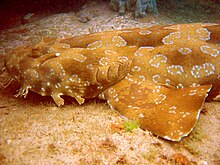
Sharks inhabit both the coastal waters and the brackish water zones of Australia. A total of 166 species are represented, including 30 requiem sharks , 32 cat sharks , six carpet sharks and 40 dogfish sharks . In 1988 a basking mouth shark was also found on Perth Beach . This species is considered to be little explored and may also be found regularly in Australian waters.
In 2004, there were 12 attacks by sharks on humans on the beaches of Australia. Two of them killed people. In general, three types of shark are considered to be particularly dangerous for humans; the great white shark , the tiger shark and the bull shark . Attacks are also occasionally carried out by Port Jackson bullhead sharks , which often rest on the bottom of flat parts of the shore. If bathers step on them, they occasionally defend themselves with bites. Some of the most popular beaches in Queensland and New South Wales are protected by nets. This measure is effective as a protection for humans, but it also has the consequence that the populations of both dangerous and harmless sharks are declining because they die if they get caught in the net.
Fishing for shark species in Australia's waters has also significantly reduced shark populations. Some species are now considered endangered.
Invertebrates
| Taxon | Estimated number of species described | Estimated number of species living in Australia |
|---|---|---|
| Porifera | 1.416 | ~ 3,500 |
| Cnidaria | 1,270 | ~ 1.760 |
| Platelets | 1.506 | ~ 10,800 |
| Acanthocephala | 57 | ~ 160 |
| Nematoda | 2.060 | 30,000 |
| Mollusca | 9.336 | ~ 12,250 |
| Annelida | 2.125 | ~ 4.230 |
| Onychophora | 56 | ~ 56 |
| Crustacea | 6.426 | ~ 9,500 |
| Arachnida | 5.666 | ~ 27.960 |
| Insecta | 58.532 | ~ 83.860 |
| Echinodermata | 1.206 | ~ 1,400 |
| Other invertebrates | 2.929 | ~ 7.230 |
| According to Williams et al. 2001. | ||
Of the approximately 200,000 animal species that live in Australia, 96% are invertebrates . 90% of the insects included are considered endemic . Invertebrates occupy numerous ecological niches and play an important role as pollinators and part of the food chain in all Australian habitats . The largest group of invertebrates make up the insects, to which about 75% of the known Australian animal species belong. The most important of these are the beetles (Coleoptera), of which about 28,000 species are known. About 20,000 other species are assigned to the butterflies (Lepidoptera) and about 12,800 to the hymenoptera (Hymenoptera). The two-winged species (Diptera), which include flies and mosquitoes , make up around 7,800 species. About 3,000 species of the right winged (Orthoptera), including grasshoppers and crickets , also belong to the fauna of Australia. For invertebrates too, introduced species have a significant negative impact on Australia's ecosystems. Introduced species that displace native species include short-headed wasps , bees , bumblebees and the red fire ant .

Australia has a large number of spiders (arachnids). This includes weaving spiders , which are also familiar to many laypeople. One of the most poisonous species is the notorious Atrax robustus , called "Sydney Funnel-Web Spider" in English. It is very poisonous and belongs to the Hexathelidae family . It occurs in the urban area and in the vicinity of Sydney and lays its funnel-shaped or tube-shaped nets in damp, cool places, even in houses. Their bite can kill a child in 15 minutes. An antidote has been available since 1980. The poisonous Latrodectus hasselti , called “Redback Spider” in Australia, which belongs to the real widows ( Latrodectus ), is a cultural successor . The female, over 10 millimeters long, who settles in and on houses, usually wears a wide, red longitudinal band on the back of the abdomen and a watch-glass-shaped, red markings on the abdomen.
Of the Wenigborstern (Oligochaeta) two families are represented in Australia: the white worms (Enchytraeidae) and the megascolecidae . The latter family includes the largest known little- bristle Megascolides australis with an average length of 80 centimeters. But specimens have also been found whose length reached 3 meters. The worms are then up to 3 centimeters thick. They live in the Australian bush and throw up small, volcanic hills above their passages, which can reach to the knee of an adult human.
About 124 species of Australian crayfish (Parastacidae) inhabit the Australian region. Some of the species can survive longer periods of drought by burying themselves up to 75 centimeters deep in the ground. Euastacus armatus , which can grow up to 45 centimeters long, is of commercial importance . Some species such as the yabbi ( Cherax destructor ) and the chestnut ( Cherax tenuimanus ) are also grown commercially in shrimp farms .
Many invertebrates are also found in the waters along Australia's coast. The Great Barrier Reef is particularly rich in species . Numerous representatives of sponges , flower animals , echinoderms and molluscs live here . There are also some very poisonous species here. These include the sea wasps , two closely related box jellyfish species (Cubozoa) that are in the same family and whose scientific names are Chiropsalmus quadrigatus and Chironex fleckeri . The latter is probably the most feared organism of Pacific bathing beaches . Whole bathing areas are fenced in in Australia to protect themselves from these animals. The blue-ringed octopus and ten species of poisonous tongue are also among the dreaded invertebrates.
In addition to the poisonous animals, other marine invertebrates are also considered problematic. The crown of thorns starfish usually inhabits coral reefs with very low numbers of individuals. For reasons that are not yet fully understood, there are occasional strong population spikes in which the hard corals are eaten faster than they regenerate. The ecosystems of the Australian coastal waters are also at risk. The ballast water brought in mussels and echinoderms , which displace the native species.
Many crustaceans are also found in the coastal waters ; these include numerous representatives of the decapods such as hermit crabs , reef lobsters , shrimps and lobsters . The lesser known groups of animals include the Remipedia , the Cephalocarida , Branchiopoda , Maxillopoda (which include the fish lice and the Ostracoda ).
Pleistocene megafauna of Australia
Australia hosted the Pleistocene an extensive large animal fauna to the huge Diprotodon , the bag rhino zygomaturus , the bag Lion , the Beuteltapir palorchestes , large sthenurinae ( procoptodon , simosthenurus ), the giant rat kangaroo propleopus , the monitor lizard Megalania and the huge bird genyornis included. In the course of the Quaternary extinction wave , Australia lost all of the 24 large animal genera (those containing representatives weighing 45 kg and more) with the exception of one, that of the large kangaroos ( Macropus ). Most of these large animal species are thought to have become extinct around 50,000 years ago, which correlates strongly with the first appearance of humans on the continent.
Australia's fauna and humans
For more than 40,000 years, the fauna of Australia has played an integral role in the traditional Aboriginal lifestyle . The animals they hunted included the marsupial mammals (e.g. the extinct marsupial ), seals and fish . Mollusks and some insect species such as the Bogong butterfly were also used as a source of food . Their way of hunting included the targeted use of bushfires . The extent to which the Aborigines are involved in the extinction of the Australian megafauna , which includes some herbivores such as the giant diprotodon , the short-snouted kangaroos and the flightless birds of the genyornis , is still debated . Archaeological evidence for this has not yet been found. Another possible cause could also have been the climate change in the Pleistocene that contributed to the extinction of the species.
The influence of the Aborigines on Australia's fauna is generally estimated to be much less than that of the Europeans, who have settled in the country since 1788. Hunting, habitat destruction and the introduction of non-native animal and plant species have so far resulted in the extinction of at least 27 species of mammals, 23 species of birds and four frogs. 380 other animal species are considered endangered. The introduction of the red fox for hunting purposes was particularly devastating, and it has spread rapidly, especially after the dingo, which had long been native to the region, had been decimated. Numerous originally widespread small mammal species in Australia fell victim to the foxes and feral domestic cats. Some, like the banded hare kangaroo and the shaggy hare kangaroo , survived at least on small islands off the mainland. Bernier and Dorre Island are important island hideaways . Other species, such as the anthill and the short-nailed kangaroo , were able to survive in tiny relic areas on the mainland. Some of them are now being released back into the wild in fenced reserves that are kept free of foxes. These include the Scotia Sanctuary in New South Wales and the Yookamurra Sanctuary in South Australia. The vast majority of Australian species are now protected by numerous laws ; this does not include some kangaroo species, which have benefited from the expansion of pasture farming and have reproduced so much that they are deliberately shot down. The protection measures include the establishment of reserves and nature reserves . The Great Barrier Reef, for example, is subject to strict protection regulations. Since 1973 there has also been a federal agency, the “Australian Biological Resources Study”, whose task includes, among other things, the systematic identification, classification and distribution of the Australian flora and fauna. All whale species in Australian waters are also protected, and Australia has signed the CITES Convention.
literature
- TM Berra: A Natural History of Australia. Academic Press, San Diego 1998, ISBN 0-12-093155-9 .
- Hans D. Dossenbach : The animal world of Australia . Silva-Verlag, Zurich 1986.
- DW Walton (Ed.): Fauna of Australia. Vol. 1A. Australian Government Publishing Service, Canberra 1987, ISBN 0-644-06055-7 .
- GM McKay: Biogeography and Phylogeny of Eutheria (PDF; 351 kB). In: DW Walton, BJ Richardson (eds.): Fauna of Australia. Vol. 1B. Mammalia. Australian Govt. Pub. Service, Canberra 1989, ISBN 0-644-05483-2 , pp. 1-1227.
- Ronald Strahan (Ed.): Complete Book of Australian mammals, the national photographic index of Australian wildlife. Angus & Robertson, London 1984, ISBN 0-207-14454-0 .
Web links
- Australian Faunal Directory . Department of the Environment and Heritage, Canberra 2005. (national online resource web portal)
- Australian Biological Resources Study
- Atlas of Living Australia
- Australia's insects
- Australia's birds
- Australian Museum , Australia's oldest natural history museum in Sydney
- Crustacean Gallery - Crustaceans of Australia
- Australian fossil sites
- Australian Venom Research Unit (description and pictures of the poisonous species of Australia)
supporting documents
- ↑ n-tv.de of January 2, 2008 , Plague and Attraction - Wild Camels in Australia
- ↑ Spiegel.de from April 1, 2009 , Wild camels cause trouble in the outback
- ^ Stan Sindel and James Gill: Australian Lorikeets , Singil Press, 2007, ISBN 978-0-9587727-8-5 , pp. 97 to 201
- ↑ Joseph M. Forshaw : Australian Parrots - Volume 2 Bretten, 1st German-language edition 2003, p. 602
- ↑ Gerhard Rösler: The wild pigeons of the earth - free life, keeping and breeding . M. & H. Schaper Verlag, Alfeld-Hannover 1996, ISBN 3-7944-0184-0 , pp. 167-172
- ↑ Hadoram Shirihai: A Complete Guide to Antarctic Wildlife - The Birds and Marine Mammals of the Antarctic Continent and Southern Ocean , Alula Press, Degerby 2002, ISBN 951-98947-0-5 , pp. 226-227
- ^ Grahame Webb, Charlie Manolis: Crocodiles of Australia . New Holland Publishers (Australia) 2009, ISBN 978-1-74110-848-4
- ↑ List of species of amphibians in Australia at Amphibiaweb
- ^ Department of Sustainability, Environment, Water, Population and Communities (2012). Scaturiginichthys vermeilipinnis in Species Profile and Threats Database, Department of Sustainability, Environment, Water, Population and Communities, Canberra. http://www.environment.gov.au/sprat (Accessed May 11, 2012)
- ↑ Petru Banaescu: Zoogeography of Fresh Waters . Pp. 1283-1305, AULA, Wiesbaden 1990, ISBN 3-89104-480-1
- Jump up ↑ Roberts, RG, TF Flannery, LA Ayliffe, H. Yoshida, JM Olley, GJ Prideaux, GM Laslett, A. Baynes, MA Smith, R. Jones, and BL Smith. 2001. New ages for the last Australian megafauna: continent-wide extinction about 46,000 years ago. Science 292: 1888-1892.
- ↑ Chris Johnson: Australia's Mammal Extinctions. Cambridge University Press. Melbourne, Australia, 2006, ISBN 0-521-68660-1





